In this Good Practice Note, Padmakumar, Ravi, Manikandan and Adithyan throw light on a digital advisory tool developed by ILRI to address the mismatch between nutrient requirement and nutrient availability in dairy animals where a mixed farming system prevails.
CONTEXT
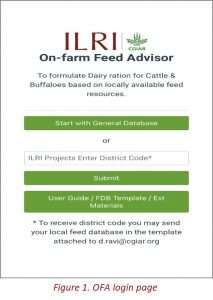 The productivity of livestock in Asia is found to be far below the global benchmark. The milk production per cattle in Bangladesh and Nepal, for instance, is only 305 kg and 459 kg per animal per year, respectively, compared to 7500 kg/animal/year in the USA and Europe (SAARC 2015). Improved efficiency of animal production is therefore critical in low and middle income countries. Poor quality and low availability of feeds are the main factors responsible for low productivity and inefficiency of livestock production (Blummel 2009). Therefore, choice of feed, its availability, feed optimisation strategy, and feed conversion efficiency play a key role in improving animal performance (Blummel et al. 2017). In the mixed farming system, generally farmers feed their livestock with whatever is available on their farm in the form of crop residues such as straw, stover, haulms, and other agricultural by-products. This basal feed is later supplemented with home-grown or purchased forage and concentrates, but with minimal understanding of the nutrient composition and actual nutrient requirements of the animal. This may, in many cases, result in over or under supply of key nutrients such as protein or energy relative to the level of production. In some instances, by not choosing the most cost-effective feed, the feeding costs are higher than they need to be. In this context ‘precision feeding’ is a technique that can be used to address the nutrient mis-match issue. It involves feeding of animals by matching the requirement of nutrients (for body maintenance, growth, pregnancy and production) with nutrient supply through the diet. The mobile phone based application called ‘On-farm Feed Advisor’ (OFA) developed by the International Livestock Research Institute (ILRI) helps farmers and extension workers to balance nutrients in the diet of dairy animals in the mixed farming context.
The productivity of livestock in Asia is found to be far below the global benchmark. The milk production per cattle in Bangladesh and Nepal, for instance, is only 305 kg and 459 kg per animal per year, respectively, compared to 7500 kg/animal/year in the USA and Europe (SAARC 2015). Improved efficiency of animal production is therefore critical in low and middle income countries. Poor quality and low availability of feeds are the main factors responsible for low productivity and inefficiency of livestock production (Blummel 2009). Therefore, choice of feed, its availability, feed optimisation strategy, and feed conversion efficiency play a key role in improving animal performance (Blummel et al. 2017). In the mixed farming system, generally farmers feed their livestock with whatever is available on their farm in the form of crop residues such as straw, stover, haulms, and other agricultural by-products. This basal feed is later supplemented with home-grown or purchased forage and concentrates, but with minimal understanding of the nutrient composition and actual nutrient requirements of the animal. This may, in many cases, result in over or under supply of key nutrients such as protein or energy relative to the level of production. In some instances, by not choosing the most cost-effective feed, the feeding costs are higher than they need to be. In this context ‘precision feeding’ is a technique that can be used to address the nutrient mis-match issue. It involves feeding of animals by matching the requirement of nutrients (for body maintenance, growth, pregnancy and production) with nutrient supply through the diet. The mobile phone based application called ‘On-farm Feed Advisor’ (OFA) developed by the International Livestock Research Institute (ILRI) helps farmers and extension workers to balance nutrients in the diet of dairy animals in the mixed farming context.
DIGITAL ADVISORY TOOL – ON FARM FEED ADVISOR (OFA)
The ‘On-farm Feed Advisor’ (Figure 1) is a mobile phone based nutrient balancing application (https://play.google.com/store/apps/details?id=org.ilri.ilrifeedadvisor) downloadable from Google Playstore or (https://apps.apple.com/in/app/on-farm-feed-advisor/id1570480676), Appstore, and can be operated by extension workers, progressive farmers, and farm managers who have some basic understanding of animal nutrition. The investment is almost zero if the users possess an android/ iOS smartphone. An experienced person may not take more than 10 minutes to input data and provide feed advice.
The tool mainly works based on two databases – such as nutritional requirement of animals (as per Indian Council of Agricultural Research standards) and nutritional quality of feeds (as estimated by ILRI using Near Infrared Reflectance Spectroscopy). The main activities to be done in the app are as follows.
Feed the data
While the nutritional requirement for body maintenance, growth, gestation (if any) and production are embedded in the backend, the user has to key in the girth (in inches) or weight of the animal, type of animal (cow or buffalo), quantity, quality and price of milk produced, type of feed fed to the animal per day, its quantity (in kg), and whether the feed is ‘own’ (available in the farm such as crop residue) or ‘purchased’ from the market (Figures 2, 3, 4).
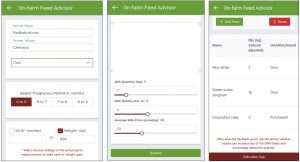 Figure 2. Farmer/animal data Figure 3. Production data Figure 4. Feed data
Figure 2. Farmer/animal data Figure 3. Production data Figure 4. Feed data
Calculate Nutrient Gap
After entering the animal and feed details, when the tool is asked to ‘Calculate Nutrient Gap’, it will show the status of nutrient shortage or surplus under the present feeding regime (Figure 5). This is estimated from the nutrient requirement and availability through the feeds provided. The system will automatically take the nutritional information and price of the locally available feeds from the local feed database, updated in advance by the local extension agent. (Note: before going to a village or farmers, the local feed advisor/extension agent has to update the feed database in the App.)
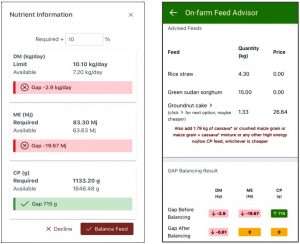 Figure 5. Nutrient status Figure 6. Feed advice
Figure 5. Nutrient status Figure 6. Feed advice
Balance nutrients
Then when we instruct the tool to ‘Balance nutrients’, the system automatically computes the cheapest ration and provides the solution (balanced diet) in such a way that nutrients in the proposed feeds match the animal’s requirements (Figure 6).
Systematic and Stepwise approach for using the App
- Installation: Download the App from the store and open;
- Enter farmer data (name, village, district);
- Input animal details (animal type, stage of pregnancy, milk production, quality and price);
- Enter feed details (feed name, quantity fed, ‘own’ or ‘purchased’);
- Click ‘calculate nutritional gap’;
- It will display the required nutrients, nutrients supplied through present feeding and shortage or surplus of nutrients. After reviewing this information, if we want to challenge the animal to produce more considering its production potential, indicate the percent of additional production (0-50% according to the genetic potential) and click ‘balance the feed’;
- It will display a page with the cheapest feed solutions indicating what feeds to be used and the quantity. It will also give additional information, such as nutrient gap before and after balancing, cost of feed before and after balancing, additional milk and income (due to feeding over and above the requirement, and predicted methane emission before and after balancing.
Now click ‘advice memo’, which will give the feed solution along with other instructions to improve the overall quality of feeding to further reduce feeding cost and to increase productivity.
Retrieving feed advice from the app
The feed advice can be converted into a pdf document and shared through electronic media or the farmer can even take a photo using his/her smartphone. The solution offered is at the individual cow level as different animals of the same farmer or different farmers may be in different physiological stages and production levels. There is also provision to retrieve the animal record of a farmer and update the recommendation (feed advice) after a period of time when milk production changes. The tool also helps to do a centralised analysis of data so as to understand the general nutritional status of animals in a given locality and helps in giving a sweeping recommendation for the location.
CHALLENGES
Least-cost ration formulation is an effective approach to optimize cost effectiveness without compromising on nutrient adequacy and quality of feed used. On-farm Feed Advisor uses least-cost ration formulation with linear programming that optimizes the inclusion of two or more ingredients subject to some constraints such that the formulated diet is nutrient adequate with the least cost possible. The tool prioritizes on balancing energy and protein requirement for different physiological stages of lactation. An accurate estimation of energy value of feedstuffs and diets are required because energy inadequate diets result in lower milk production, weight loss, impaired reproduction, and lower immunity to diseases. On the contrary, excess energy results in lower profitability of dairy farms, produce fat cows, and may induce metabolic disorders. Total digestible nutrients have been the most common method of expressing energy requirements mainly due to the presence of a large database of TDN values of feed ingredients. However, TDN does not account for all energy losses, including gaseous and urinary energy, and heat increment. In current models of nutrient requirements, energy requirements are defined as either metabolizable energy (ME) accounting for energy losses through faeces, urine, and gases, and net energy (NE) system accounting for energy losses via faeces, urine, gases along with heat increment. Crude protein content has been used for formulating diets for lactating dairy cows and the On-farm Feed Advisor uses CP content of feed ingredients for balancing CP requirements of dairy cows.
All extension agents who are associated with livestock production can use it. It includes veterinary officers, paravets, dairy cooperative staff, animal health workers, livestock-based NGOs, feed company field staff, feed retailers, etc. One of the prerequisites of using the OFA Tool is preparing the local feed database in which information on price, nutritional content (ME, CP) and market availability are included. Initially, one can use book values for the nutritional information but it can later be replaced with lab values for accuracy. This is the initial work the extension agent has to do before going to farmers to provide feed advice.
The limitations of the App are that it cannot be used for meat animals or poultry, it considers only energy and protein status and doesn’t reflect the mineral and vitamin requirement/availability of the diet. The methane estimation is based on an old mathematical model, which is currently under review. Further, OFA is currently available only in the English language, but it can easily be made multi-lingual.
INITIATIVES FROM ILRI TO PROMOTE THE APP
The App has been pilot tested in four districts of Karnataka (Chikkaballapur, Dharward, Raichur, and Bidar districts) and in Bhanur district and Mulkanoor dairy cooperative in Telangana. Besides, we have trained extension staff of Shakti Dairy (15) and ABT Foods (18) based on their demand. We got only anecdotal evidence on the impact. The App is currently under consideration for implementation in the Rwanda Dairy Development Project. We introduced the App to the ILRI scientific group for its use in ILRI projects in various countries. We have already planned for a training to those who have shown interest. Therefore, it is still at the pilot stage and promotional activities are yet to start on a larger scale for other global users. This good practice is an attempt to introduce the App to other global users. It has not yet been shared on other media.
IMPACT
The feed balancing application is a boon in animal production as it enables extension workers deliver feed advice with minimum effort. To start with, one can use reference values from standard nutritional tables but can validate the same by analysing feed samples collected while visiting the field. The main investment required is for preparing the feed database for specific locations. After the initial use, one can always retrieve the farmer/animal records, update the input data and get new results. Since smart phones are nowadays available with most of the extension workers, the work will definitely become much easier. The On-farm Feed Advisor is currently being used in different projects in Karnataka, Maharashtra, and Tamilnadu states and we are getting encouraging response from the field staff. The increase in milk production and reduction of feed cost when calculated on a yearly basis for 2-3 cows or buffaloes is significant enough to motivate smallholders to go for feed balancing based on locally available feed resources. Studies by Garg et al. (2013) show that the implementation of ration balancing programme by the National Dairy Development Board in India improved (P<0.05) daily milk yield in buffalo and cattle between 2% and 14% (average 3.7%) under field conditions; and milk fat level between 0.2% and 15% (average 4.6%) while at the same time reducing feed costs. The overall outcome was an increase in net daily income of farmers per animal – ranging from 6% to 60% with an average of 16.0%. This is a remarkable result.
The On-farm Feed Advisor is best suited to balance animal diets of smallholder crop-livestock-dairy farmers. The tool can help formulate a cheaper diet with locally available feed ingredients. Apart from energy and protein balance, the tool provides very useful information about the quality of feed such as dry matter percentage of the advised feed (ideally <70%), Neutral Detergent Fibre (ideally 25-50%), feed cost before and after balancing, and predicted emission of greenhouse gases before and after balancing the diet. It also has a provision to challenge the animal by adjusting the requirement (manually) to an additional 1-50% depending on the genetic potential and current production level of the animal.
The original version of the application had no provision for registration and track the users on its application. So we couldn’t track its wider applications in the field apart from anecdotal evidence from among the ones to whom the app information has been disseminated and who are also trained on its application. In the recent version, the tracking system is available but the impact is yet to be assessed based on its application.
SUSTAINABILITY AND SCALING UP
In the smallholder animal production context, feed has always been an issue in Asia. Crop residue having low level of nutrients is the single most important feed resource in the region. Though several feed technologies are available, they are seldom adopted by farmers due to various limitations. Therefore, it is high time to have a combination of different approaches. Of the different feeding strategies and approaches, precision feeding using nutrient balancing tools, especially mobile phone- based user friendly apps, can support extension workers in providing valuable advice to farmers to help them slightly modify their current feeding regime so as to match production requirement and supply. This will also help in tapping the genetic potential of animals and reduce the yield gap. It is needless to say that policy support is very much required to scale up the technology by training line department staff, extension workers, dairy cooperatives, private feed companies and farmers. It will also be good to include this subject in the curriculum of veterinary students and in para-veterinary trainings. Though the On-feed Advisor was initially developed for use in India, it can now be applied in any country where the customer can self-populate data and use it freely.
ENDNOTE
This digital advisory tool can potentially help to reduce the yield gap in dairy animals in the mixed farming systems and can help reduce cost of feeding to below 60%. We hope this will be of great help to both farmers and extension agents working in the crop-livestock sector.
REFERENCES
Blummel M, Anandan S and Prasad CS. 2009. Potential and limitations of by-product-based feeding systems to mitigate house gases for improved livestock productivity. 13th Biennial conference of ANSI, December 17-19, 2009 NIANP, Bengaluru.
Blümmel M, Muller A, Schader C, Herrero M and Garg MR. 2017. The use and abuse of cereals, legumes and crop residues in rations for dairy cattle. Burleigh Dodds Science Publishing Limited.
Garg MR, Sherasia PL, Bhanderi BM, Phondba BT, Shelke SK and Makkar HPS. 2013. Effects of feeding nutritionally balanced rations on animal productivity, feed conversion efficiency, feed nitrogen use efficiency, rumen microbial protein supply, parasitic load, immunity and enteric methane emissions of milking animals under field conditions. Animal Feed Science and Technology 179:24-35.
SAARC. 2015. Member and State Information. Tarawali S, Herrero M, Descheemmaeker K, Grings E and Blummel M. 2011. Pathways for sustainable development of mixed crop livestock system: Taking a livestock and pro-poor approach. Livestock Science 139:11-21.
 Padmakumar Varijakshapanicker, Acting Head, Feed Technology Research Platform, ILRI, Patancheru, India. He can be reached through email: v.padmakumar@cgiar.org
Padmakumar Varijakshapanicker, Acting Head, Feed Technology Research Platform, ILRI, Patancheru, India. He can be reached through email: v.padmakumar@cgiar.org
 Ravi Devulapalli, Lead Scientific Officer, ILRI, Patancheru, India. He can be reached through email:D.Ravi@cgiar.org
Ravi Devulapalli, Lead Scientific Officer, ILRI, Patancheru, India. He can be reached through email:D.Ravi@cgiar.org
 Manikandan V. Software Engineer. 32, Raja Godown Street, Arcot, Vellore 632512, India. He can be reached through email: dineshmani333@gmail.com
Manikandan V. Software Engineer. 32, Raja Godown Street, Arcot, Vellore 632512, India. He can be reached through email: dineshmani333@gmail.com
 Adithyan, A. Software Engineer, Chennai, India. He can be reached through email: adhix11@gmail.com
Adithyan, A. Software Engineer, Chennai, India. He can be reached through email: adhix11@gmail.com

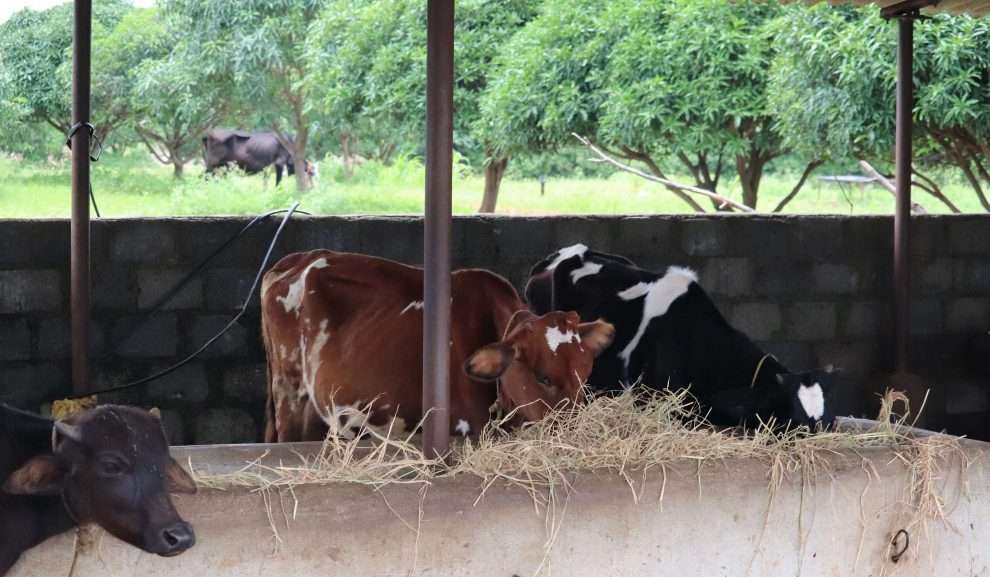
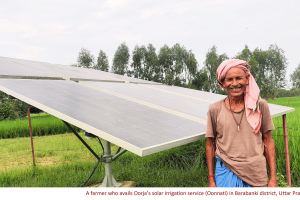
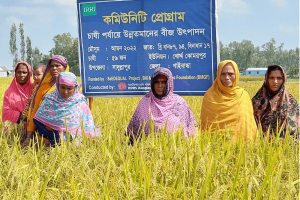
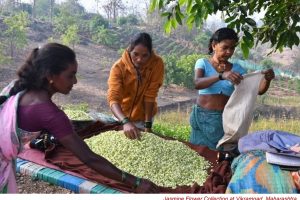
“Congratulations, to Dr. Padmakumar and his team on developing ILRI’s digital advisory tool to reduce yield gap in dairy animals.
My observations are:
1. When we recommend that a particular quantity of compound concentrate feed ( usually supplied by Milk Unions and some private feed mixing units) to a cow based on its body weight and milk yield etc, most of the dairy farmers complain that the recommended feed quantity is not supporting the milk yield and hence they usually add wheat bran and other feed ingredients to the recommended quantity of compound concentrate feed. Because of this the phrase “Farmer formulated feed rations “ came into existence.This is the situation when the feed mixing plants use LCC of resources to reduce the cost of production. How this tool is designed to address this issue?
2. The authors mentioned that this tool was pilot tested in some places in Karnataka and Telangana. What were the farmers’ responses and whether any modifications were introduced in the tool based on their responses?
It is good to know that this tool is being tried in several other places and I am sure that the results of such on farm trials will help in refining this tool”
“Many thanks Prof Rao for your valuable comments. Our comments on your two specific points are as follows:
Point 1: The feed database in the tool is created by analyzing samples of feeds available in the locality for their nutritional content. So, the nutritional value will be accurate and not as claimed by feed companies
Point 2: Anecdotal evidence shows that the cost of production got reduced. We are in the process of conducting an impact study with the help of students.
Great step in crop-livestock husbandry to raise yield, reduce cost and benefit farmers and consumers. Congrats!